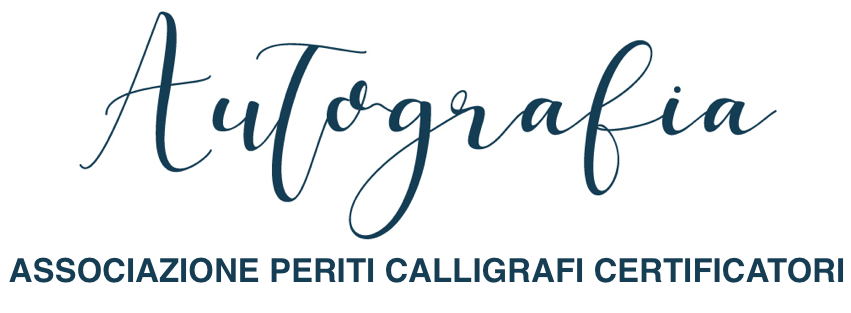Napoleon Bonaparte’s autograph and forgeries: an amazing case study
Napoleon’s autograph is certainly one of the most coveted by collectors from all over the world and of all eras. Just think that when Napoleon himself was still alive the interest in the documents written by his hand was so high that numerous fakes were already in circulation at the time.
With this article we want to share the outcome of the studies carried out on the intriguing question that sees protagonists various documents, literally scattered around the world, all attesting to the signature of Napoleon and united by a common denominator: that of being real identical forgeries.
Autografia – Association of Calligraphy Appraisers and Certificators came across these precious documents following a discussion with a collector who brought to the attention of the experts an interesting letter which, however, aroused reasonable suspicions both for the graphic combination and for the content . After a careful examination of the document – and with the support of the study published by Peter Hicks entitled Autograph Bonaparte Letters at The Universities Of Princeton (USA) and Vilnius (Lithuania). A Tale of Napoleonic Forgeries ?, Autografia – Associazione Periti Calligrafi Certificatori was able to find that it was a ‘new’ letter never before examined which, while maintaining a certain market value, cannot be ascribed in the most absolute way to the Napoleon’s hand nor to his will. The forger who reproduced these documents seems to have combined different letters, making them one. These documents, although original by Napoleon, were nevertheless produced by him at different times. In this way, the forgerer, in addition to creating and circulating forgeries, also caused that a deviated image of Bonaparte was reconstructed, to whose words, based on the aforementioned documents, an intentionality different from that actually expressed is attributed . This counterfeit operation was repeated several times to produce an as yet undefined number of “author forgeries”.
Below we give an idea of the specimens that have so far been found and which we have had the opportunity to study.
A very interesting document is kept in the library of the University of Princeton: it is a letter, accompanied by a postscript, sent by Napoleon to an anonymous citizen. In the body of the letter, the general in charge of the Italian army, exhausted, asks for support so that he is granted a request for leave from the army and is granted a rest in France. In the postscript, however, Napoleon cursed all women and in particular his wife.
This document – bearing the signature: Princeton University Library, General Mss [Misc.] C0047, Box NA, Subfolder 1, 1 letter [1796?] Without recipient; place: Passariano; date: 4 Vendémiaire, 25 Septembre [1797] – certainly dates back to 1797 because, although the date has not been recorded, that year is the only one during which Napoleon has ever been in Passariano.
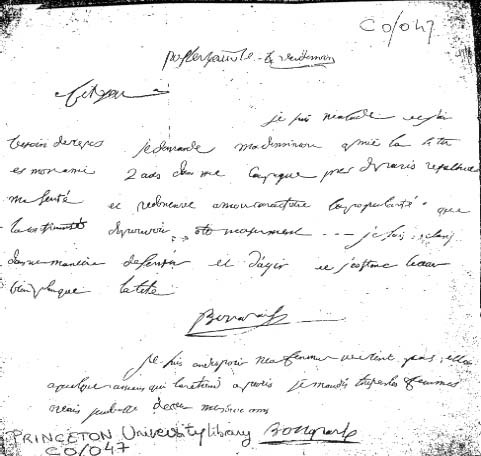
Another document with identical content was released by the Vilnius University library – signature: VUBRS F48-300.
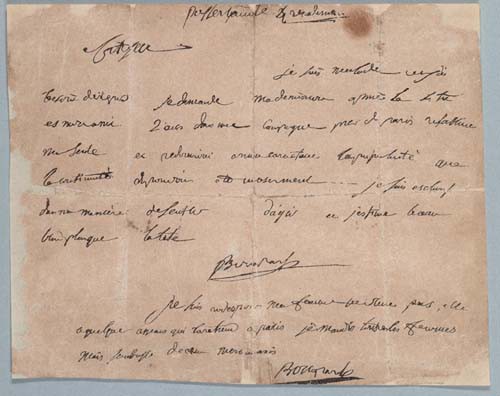
A letter cited in the memoirs of the Count of Viel-Castel was also examined: Mémoires du Comte Horace de Viel-Castel sur le règne de Napoléon III, 1851-1864, Paris: chez tous les libraires, 6 vol Addressee: Barras; place: “Italy”; no date specified.
Within the vol. 2, p. 100 (on Friday 19 November 1852) of the aforementioned memo read the following words: «A letter from Bonaparte to Barras, dated Italy (sic) is currently on sale at an armor dealer and curiosity lover, residing on the Quai Conti. The future emperor complains of Giuseppina and her preference of being in Paris with her lovers rather than obeying the call of duty and coming to his side. The general complains a lot about women, he says he needs calm and rest and wants to get a two-year leave. ” This document would appear identical to the Princeton and Vilnius documents.
Below is the full text of the documents:
Letter body
“Citoyen, Je suis malade et j’ai besoin de repos, je demande ma démission, appuie-la si tu mon ami. Deux ans dans une campagne près de Paris rétabliraient ma santé et redonneraient à mon caractère le popularité que la continuité du pouvoir ôte nécessairement … Je suis exclusif dans ma manière de sentir et d’agir et j’estime le coeur bien plus que la tête. Bonaparte. “
Postscript
«Je suis au désespoir ma femme ne vient pas, elle a quelque amant qui la retient à Paris, je maudis toutes les femmes mais embrasse de coeur mes bons amis. Bonaparte. “
Finally, a very interesting document emerged which was reproduced and published by Jacques Arnna in Pages de l’épopée impériale, Tours, 1952, pp. 86-88. The date (4 Vendémiaire [1797]), the place (Passeriano) and the writing (by Bonaparte) are identical to those of the Princeton / Vilnius documents, but there are two important differences: firstly, Arnna’s letter is explicitly addressed in Barras and not to an anonymous «Citoyen», secondly, the body of the letter from the Princeton / Vilnius documents appears to be a simple extract from what we can read in Arnna’s letter, which therefore appears much longer.

We can then assume that this document is the original from which the text of the Princeton / Vilnius documents was extrapolated. In confirmation of this hypothesis, the final part of Arnna’s letter is found and – it is now understood – missing the last part of the Princeton / Vilnius documents.
In addition to these letters, six partial documents have been found which attest portions of the aforementioned text, therefore they are documents related to them which however report either the body alone or the postscript of the letter, but never both. These documents are:
1) S.H.A.T. document (Service Historique De L’armée De Terre):

it is a complete minute comprising the body of the letter of Princeton / Vilnius documents; Press-mark: S.H.A.T., C1712; Minuta (hand of the copyist); Recipient: Barras; place: Passariano; date: 4 Vendémiaire, An IV (crossed out and corrected in An VI), September 25, 1797. The text here is that of the body of Princeton / Vilnius documents.
2-3) Document containing the body of the letter and the postscript of the Princeton / Vilnius documents published separately with facsimiles by the Baron of Coston: Le Baron de Coston, Biographie des premières années de Napoléon Bonaparte, c’est-à-dire depuis sa naissance jusqu’à l’époque de son commandement en chef de l’armée d’Italie; avec un appendix renfermant des documents ou inédits ou peu connus, postérieurs à cette époque, Paris; Valence: Marc Aurel frères, 1840, 2 vols.
Coston published the body of the letter of Princeton / Vilnius documents on page 484 of volume 1, with facsimile

here the recipient is not reported, but according to the Coston’s opinion should be addressed to Barras; place: Passariano; date: 4 Vendémiaire (Coston given the document to An VI, 1797).
Coston also published the postscript of Princeton / Vilnius documents on page 466 of volume 1, with facsimile
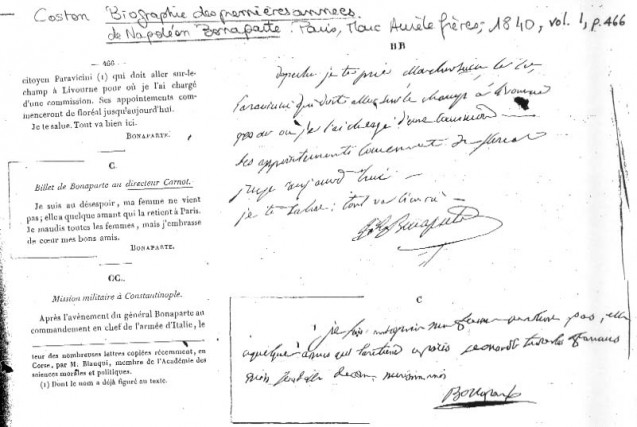
the recipient is not reported here too, but according to Coston it should be addressed to Barras; without place or date. In a footnote, Coston noted that the recipient could be neither Carnot nor Clarke.
4) Document once part of the Emile Brouwet / Musée Napoléon collection in Digne-les-Bains

which includes a letter to Barras and the postscript of Princeton / Vilnius documents. Recipient: Barras; place: Milan; date: 23 Prairial, An IV (June 11, 1796). This is the body of Bonaparte’s letter to Barras (copyist’s hand) followed by the postscript (autograph, Napoleon’s hand) of the Princeton / Vilnius document. According to the sales catalog of the Brouwet collection, Bonaparte wrote the following address on the envelope: “Au citoyen Barras, membre du Directoire, exécutif, Paris” (A Citizen Barras, member of the Executive Directory, Paris).
5-6) Document containing the body of the letter and the postscript of the Princeton / Vilnius documents published separately by Léonce de Brotonne, Lettres inédites de Napoléon Ier, 1898, nn. 9 and 13;
No. 13, body of the letter of the Princeton / Vilnius documents. Recipient: Barras; place: Passariano; date: 4 Vendémiaire An V [I] (25 September 1797)
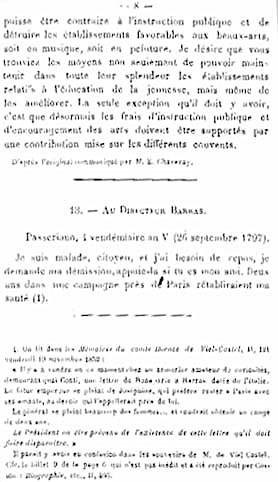
Brotonne published only a part of the text (up to “santé”). It is possible that Brotonne took the recipient, Barras, from Coston, whom he cites (No. 13, note 1).
No. 9, postscript of Princeton / Vilnius documents. Recipient: Carnot; without place or date
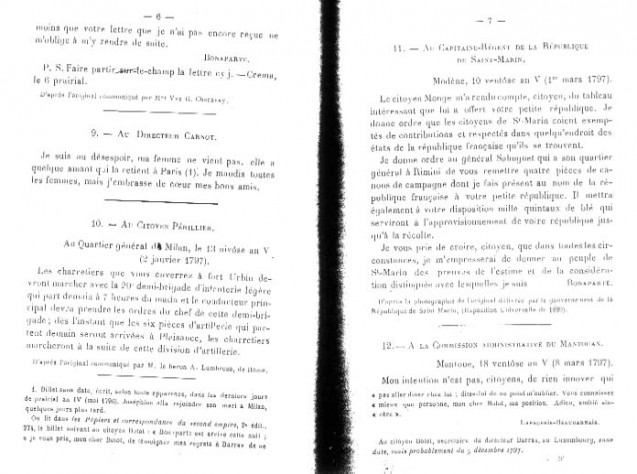
It is possible that Brotonne took the recipient, Carnot, from Coston, whom he cites (n. 13, note 1). In a note to n. 9, Brotonne dated this postscript to the “derniers jours de prairial an IV (mai 1796)” – the last days of Prairial, An IV (May 1796).
Coston (1840) and Brotonne (1898) published the body of the letter and postscript of the Princeton / Vilnius document separately (with Coston facsimile), while the minute S.H.A.T. shows us the body of the letter of the isolated Princeton / Vilnius document, therefore without a postscript. As for the recipient, despite the fact that the autograph (Princeton / Vilnius and Coston’s facsimile) does not include any, the small S.H.A.T. and the documents Coston and Brotonne unanimously demonstrate that the body content of the Princeton / Vilnius letter is addressed to Barras and that the letter was dated September 25, 1797. On the other hand, the other letter addressed to Barras (previously collected in Brouwet) , shows us the Princeton / Vilnius postscript attached to another body of letters dating back one year.
Is it then possible to support the hypothesis that the documents of Princeton, Vilnius and those mentioned in the Memoirs of Viel-Castel are unions of documents drawn up on different dates, even if apparently original and by the hand of Napoleon? Considering the chronology and history of the relations between Bonaparte, Barras and Josephine, this is very likely.
Recapitulating, as regards the postscript, the letter to Barras (as previously mentioned collected in Brouwet) places it in June 1796. This dating seems to fit perfectly because Bonaparte married Josephine in March 1796, but left almost immediately for Italy . In June Bonaparte waited impatiently for her arrival, who was lingering in Paris instead.
The postscript reveals to us a husband anxious to reunite with his wife, residing in Milan, who entrusts Barras – dear friend of the couple – with a very delicate communication placed at the end of an official letter sent by Bonaparte himself (the address is written by his hand). This postscript could therefore be reasonably dated 11 June 1796, especially since Josephine arrived in Milan on 10 July 1796.
As for the body of the letter, however, the date on the Princeton / Vilnius documents is September 1797. In fact, in addition to the fact that Bonaparte was in Passariano between September and October 1797, it was also concurrently closing the the first Campaign of Italy and, as can be seen from the letter, Bonaparte, tired, needed rest. So he asks for support for his leave request. The content and chronological correspondence is unexceptionable.
It is therefore impossible to think that the postscript that reads: «I am desperate. My wife is not coming. He has a lover who keeps her in Paris. Damn all women … »is contextual to Passariano’s letter of 1797, especially since Josephine was at that time alongside Bonaparte in Villa Manin, near Passariano. By virtue of these considerations we can confidently affirm that the postscript, placed chronologically in 1796, does not belong to Passariano’s letter, placed chronologically instead in 1797, and that consequently the Princeton / Vilnius documents are real compilations, a kind of collage.
The documents examined by the Autografia experts must necessarily be added to the documents examined above, glad to be able to help shed light on one of the most sought-after autographs ever, here they propose the description and the calligraphic analysis.

The document – to which we will refer from now on with the abbreviation FR08BT20 – is identical in every part to that of Princeton / Vilnius, with the exception of the fact that it does not present the postscript, but only the part relating to the body of the letter which it is unchanged in terms of content. Also in this case the place is Passariano, the date is that of the 4th Vendémiaire and the recipient is an anonymous «Citoyen». However, calligraphically speaking, it is possible to highlight a notable difference in composition.
Calligraphic analysis also chronologically places the document at the end of the 1700s, in fact, the signature variant here attested, that is Bonaparte’s autograph characterized by the closing flourish.
For the general analysis of the document, it is interesting first of all to note that the letter is well-ordered, with words spaced far apart, almost lined up, and how the writing line is always well respected, as the same distance is carefully maintained between the lines. This precision is the first fact that alarms us since we know well that the handwriting of Napoleon Bonaparte in that historical period appeared rather disordered, with words very close to each other and with the writing line decidedly falling downwards in the final part of the row. Another feature that immediately catches the eye is the slowness of the stroke, sometimes even trembling, therefore impossible to attribute to a man of about 30 years, typical instead of the stroke of most forgetters who, necessarily, must write slowly to better reproduce the calligraphy of the personage they are falsifying.
Analyzing the signature in detail, we can see that the counterfeiter, while imitating Napoleon’s handwriting very well, closes the signature with a decidedly anomalous flourish that closes the signature correctly, albeit indecisively, but is positioned at the base of the T-bar, while in the original the flourish is positioned on head of the letter.
Going into the examination of the single letters, among all the inconsistencies, major or minor, we point out a significant writing inconsistency in the first “Je suis”, where we can see a J with evident (false) eyelet, and an S drawn straight while in the original spelling it appears wavy. The second “Je suis” is even written in a still different way, with the letter E sticking to the letter S; even this feature is not present in the original calligraphy of the Emperor.
To conclude, the new document analyzed, even if reproduced with art, is to be considered a fake for the aforementioned reasons and therefore cannot be ascribed – neither in the handwriting nor in the signature – to the hand of Napoleon Bonaparte. In any case, together with the other documents, it becomes a witness to a grandiose falsification operation which has deceived scholars and enthusiasts, also very competent, and which, on the whole, maintains a significant historical and market value.
Matilde Gamannossi Degl’Innocenti e Stefano Fortunati

